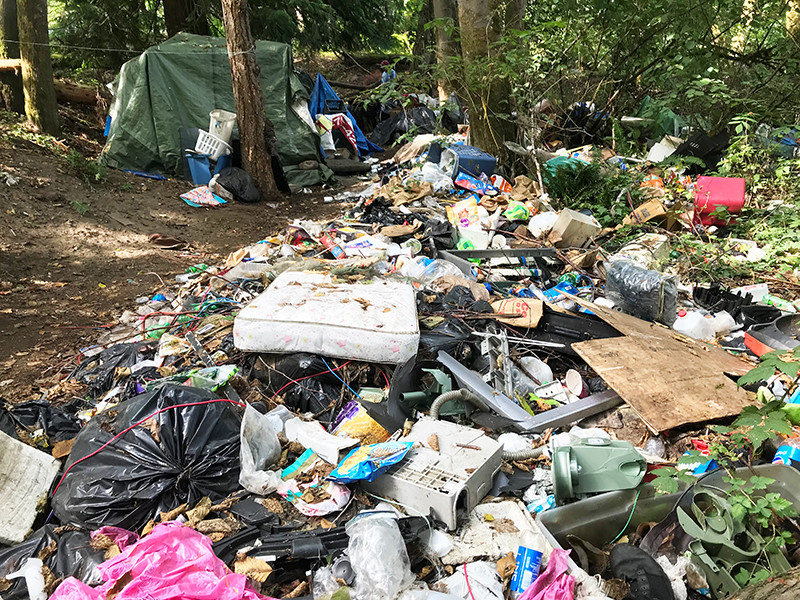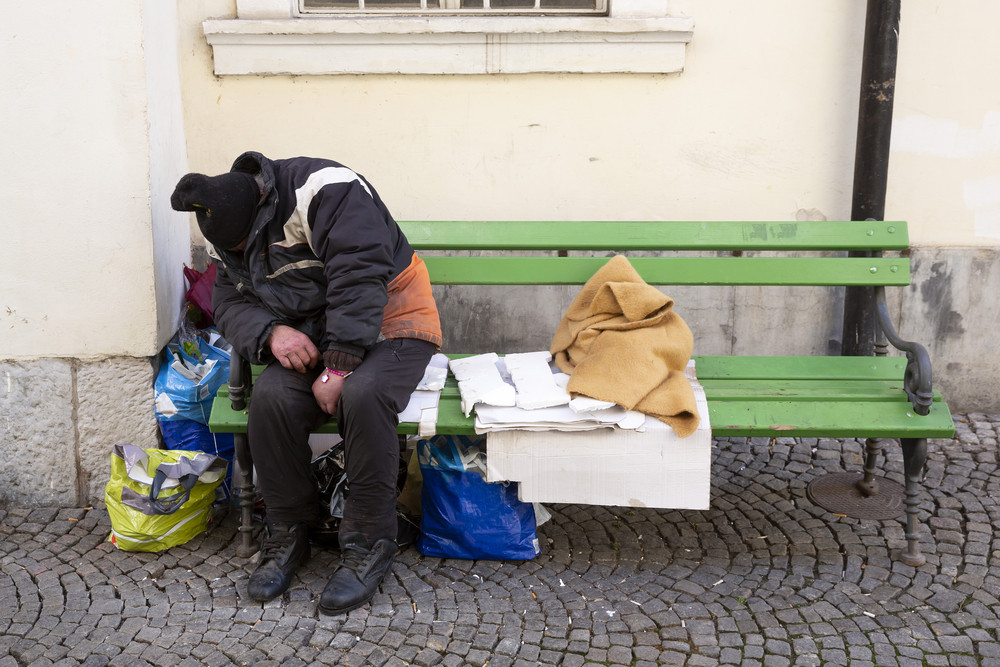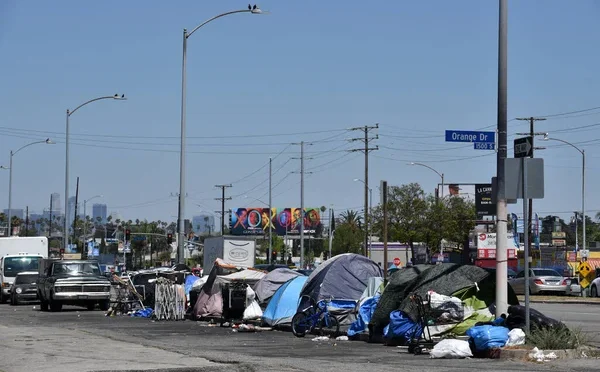“There’s no question that marijuana and other drugs – in combination with mental illness or other disabling conditions – are essential contributors to chronic homelessness.” Senator John Hickenlooper made that statement when he was governor of Colorado in 2017.
“This is one of the results of the legalization of marijuana in Denver, and we’re going to have to deal with it.” Mayor Michael Hancock was talking about a violent incident on 16th Street Mall. He described the “urban travelers” who came to Denver following legalization. That was seven years ago, and a new mayor will have to deal with the problem, a problem that now extends to more cities.
Photos of unhoused people living in squalid camps of Los Angeles (shown above), Portland and Seattle show up in our social media feeds. They’re taking over the streets in San Francisco, Vancouver and Denver. New York City, with its 1400 illegal pot shops, has a growing homeless population, too.
And although homelessness is a national problem, and substance abuse is not the only cause, the common factor of the worst-hit cities and states is legalized marijuana. In some areas, it has reached crisis levels. Even local leaders have declared a state of emergency to address the urgency of the situation.
Drug propagandists advocated long and hard to establish the “West Coast of Weed,” an area that has become the epicenter of the crisis. British Columbia which connects the western US to Alaska, is home to Vancouver which also has extreme problems of drug abuse and homelessness.
It’s NOT a Coincidence
Reviewing the statistics, a link between marijuana legalization and homelessness appears undeniable. Take a look at the homelessness crisis in some of the most pro-marijuana cities in America (19 of the top 20 have legalized marijuana)
How ironic that our wealthiest cities – cities with high-paying, high-tech jobs, have the most homelessness! Partially, it’s because of the tolerance and respect for drug use in these cities. But it’s also because those cities have policies that promote drug tourism and encourage people to use drugs.
An article in the Seattle Times showed homelessness rates are much higher in states where recreational cannabis is legal than in states where it is not.

Highest (All Legal States)
Homeless persons per 10,000 residents
- New York: 45
- California: 41
- Oregon: 35
- Washington: 35
- Massachusetts: 26
Lowest (All Illegal)
- Ohio: 9
- Texas: 9
- Pennsylvania: 10
- Florida: 13
The unhoused population is so much lower in Texas and Florida, even though they are the second and third most populous states. Both have warm climates that are expected to attract those without a permanent home.
Of special relevance, it is not just the rate of homelessness in legalization states, but also how fast the unhoused population is growing. Not surprisingly, the states with the largest increases between 2007 and 2021 allow recreational use:
- Colorado: +266%
- Nevada: +261%
- New York: +135%
- California: +101%
- Washington: +59
Legal Weed Paves the Way for Other Drugs and Mental Illness
But how did we get there? Scott Lindsey, Crime Policy Advisor for Seattle said: “The increase in street disorder is largely a function of the fact that (drug) possession has been largely legalized in the city over the past several years. The unintended consequence of that social policy effort has been to make Seattle a much more attractive place to buy and sell hardcore drugs.”
According to the National Alliance to End Homelessness, 68% of cities report that substance abuse is the single largest cause of homelessness. This is extremely relevant because numerous studies have found a link between marijuana use and the use of other drugs.
For example, among people for whom marijuana is the first drug consumed, nearly 45% will go on to use at least one other illicit substance. The risk of progression increases for individuals who smoke pot frequently or who initiated use at an early age.

Drug legalization and easy access to drugs pave the way for homelessness. If we stop legalizing cannabis and other pro-drug policies, we can stop growing this problem which robs humans of their dignity. It is estimated that up to 25% of the U.S. homeless population struggles with severe mental illness, compared to just 6% of the general population.
This is relevant to the legalization debate because there is an established link between cannabis use and poor mental health. In fact, out of all the drugs that cause temporary psychosis, marijuana has the highest rate of progression to chronic mental disorders.
In fact, 47% of marijuana users who experience psychotic symptoms will eventually develop another mental illness, such as bipolar disorder or schizophrenia. For comparison, the rate for amphetamines is 32%: Hallucinogens, 28% and Opioids, 21%.
Legal Marijuana Hurts Affordable Housing
“(Boards and landlords) certainly can say that you cannot utilize a device, whether it’s a nicotine cigarette, or marijuana, or a vapor device, that’s going to emit a carcinogen…(that could) have an adverse impact on others.”
~ Dan Zimberoff, a San Diego attorney who specializes in Homeowners Associations
The evidence shows that the legalization of marijuana affects both home values and rental costs, sending them both quite literally through the roof.
High Home Values
The first two states to open marijuana dispensaries in 2014 – Colorado and Washington – home values increased 58% and 57%, respectively in the next five years.
And while that may sound like a good thing for existing homeowners, it makes does make it that much harder for some people to afford to buy a house. The national average increase during that period was around 30%.
One prominent moving company discovered a telling statistic when looking at the approximately 1500 inbound moves that it handled to U.S. states that have recreational marijuana.
Nearly 5% of customers specifically mentioned legal weed as a factor in their decision to move. The fact that they mentioned this unasked and unprompted means that the actual percentage is probably much higher. And that’s just one company.
Rising Rents
Likewise, rent rates in states with legalized recreational cannabis spiked shortly thereafter. For example, between 2014 and 2018, the average rental cost in Denver jumped 33%.
Part of the reason for these increases is a greater demand from the marijuana industry for commercial properties – warehouses (+42%), retail space (+27%), and land (+21%). Meeting this demand often comes at the expense of new residential development. Many private homes are being converted to serve the needs of the cannabis industry.
Property owners can realize a quick and profitable return on their investment if they lease to commercial marijuana tenants. Commercial rent rates climbed by 27% in Portland and Seattle in the first few years after legalization.
In a strange twist of fate, there is another related factor that makes it tougher on renters. In addition to higher rents, up to 67% of residential property managers in legalization states ban smoking on the premises.
There are too many people trying to move into too few affordable homes, and relocating for marijuana is only exacerbating the problem of an already precarious situation.
Learning from Every Pro-Marijuana State
“Legalized and “legitimized” marijuana use and the poly drug use that has been associated with it are major contributing factors in the growth of conditions similar to refugee camps, massive homelessness, mental illness, violence, crime, and a myriad of health and safety problems that are now found in once beautiful cities and areas of the country.”
~ Dr. Paula D. Gordon, Ph.D.
Supporters of expanded legalization will argue that correlation does not necessarily equal causation. But the homelessness problem keeps growing worse in legalization states compared to other parts of the country
Again, this is not just a coincidence.
There is no one cause of homelessness. However, in legalization states, substance abuse, mental illness and a lack of affordable housing options contribute largely to this crisis.
Marijuana is behind each one of those first two factors. When people move to states to get into the cannabis industry, it also contributes to the third factor.
The problems faced by places like Los Angeles, San Francisco and Denver and so many other pro-cannabis cities, counties, and states highlight the tragic consequences of legalization, not just to individuals and families, but to society as a whole.
**********
SOURCES
Drugs, Homelessness & a Growing Public Health Disaster
Is Colorado’s homeless surge tied to marijuana legalization?
We Found the Best Weed Cities in the U.S. (2022 Data)
L.A. County poised to declare state of emergency over homelessness crisis
See how Seattle’s homelessness crisis stacks up across the country and region
State of Homelessness – Archives
How Colorado’s homeless problem compares to other states
Marijuana Has Proven to Be a Gateway Drug
How Many Cannabis Users Start Taking Other Drugs?
The Complex Link Between Homelessness and Mental Health
Marijuana industry draws homeless to Colorado for jobs
New Study: How Legalizing Recreational Marijuana Impacts Home Values
The True Cost of Marijuana Legalization
The Effects Of Marijuana Legalization On American Real Estate
Are People Moving To States Where Marijuana Is Legal?
Welcome to Denver — a ‘hellhole’ of drugs
Homeless encampment cleanup will help protect Washington residents from contamination
Homelessness in San Francisco: talk of frustration, survival
The ongoing crisis of homelessness in the Bay Area: What’s working, what’s not
We recommend the book by Michael Shellenberger, San Fransicko, 2021, although he does not link the problem to marijuana legalization as we do.
A recent video about Portland’s homelessness problem blames Measure 110 which legalized all drugs. However, we know the problem began when the first recreational cannabis shops opened around 2016.

